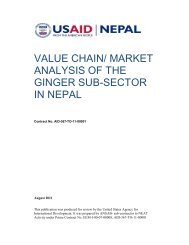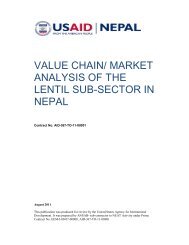value chain/ market analysis of the orthodox tea sub ... - Nepal Trade
value chain/ market analysis of the orthodox tea sub ... - Nepal Trade
value chain/ market analysis of the orthodox tea sub ... - Nepal Trade
Create successful ePaper yourself
Turn your PDF publications into a flip-book with our unique Google optimized e-Paper software.
organization also serves as a forum for small <strong>tea</strong> growers to lobby for supportive policies at<strong>the</strong> national level.3.5.3 Government Agencies and projectsMinistries and National Planning Commission (NPC): The Ministry <strong>of</strong> Agriculture andCooperatives, Ministry <strong>of</strong> Commerce and Supplies and Ministry <strong>of</strong> Industry are directly andindirectly involved in providing support to <strong>the</strong> <strong>tea</strong> sector and are responsible for formulatingand executing policy at <strong>the</strong> national level. The National Planning Commission is <strong>the</strong> centralbody for devising development planning in <strong>the</strong> <strong>tea</strong> sector.District Agriculture Development Offices (DADO): DADOs operate under <strong>the</strong> Department<strong>of</strong> Agriculture <strong>of</strong> <strong>the</strong> Ministry <strong>of</strong> Agriculture and Cooperatives and is functional in all 75districts. DADOs are <strong>the</strong> main points <strong>of</strong> reference for activities related to agriculture in anygiven district. Group formation, technical advice to producers, technology demonstrations,and trainings are some <strong>of</strong> <strong>the</strong> activities DADOs are involved in.National Tea and C<strong>of</strong>fee Development Board (NTCDB): The NTCDB was established in1993 under <strong>the</strong> Tea and C<strong>of</strong>fee Development Board Act <strong>of</strong> 1992. Its main objective is t<strong>of</strong>ormulate plans and policies for <strong>the</strong> development <strong>of</strong> Tea and C<strong>of</strong>fee at <strong>the</strong> national level andto streng<strong>the</strong>n <strong>the</strong> public, private sectors involved in <strong>the</strong> Tea and C<strong>of</strong>fee industry. It has twoRegional Offices and seven Tea Extension projects.Streng<strong>the</strong>ning <strong>of</strong> Environmental Administration and Management at <strong>the</strong> local level(SEAM-N): SEAM-N is a project that began in 2001. It is led by <strong>the</strong> GoN and Finland andone <strong>of</strong> its primary activities is <strong>the</strong> production <strong>of</strong> bio-slurry and converting farms to organic.Commercial Agriculture Alliance (CAA)/Commercial Agriculture Development Project(CADP): CADP manages <strong>the</strong> Commercial Agriculture Fund (CAF), a cost-sharing grantprogram available to CAA general members to streng<strong>the</strong>n <strong>market</strong>-<strong>chain</strong> activities anddevelop linkages within <strong>the</strong> <strong>market</strong> <strong>chain</strong>. Some <strong>tea</strong> producer cooperatives and <strong>tea</strong> factoriesalready have joined CAA, thus becoming eligible to get project proposals approved forimplementation.<strong>Trade</strong> and Export Promotion Centre (TEPC): The Government <strong>of</strong> <strong>Nepal</strong> established a"<strong>Trade</strong> and Export Promotion Centre" in 2006. TEPC is a national trade promotionorganization with <strong>the</strong> primary objective <strong>of</strong> promoting trade. TEPC has been providingsupport to HOTPA/HIMCOOP in trade fairs.3.6 Policy FrameworkThe Government <strong>of</strong> <strong>Nepal</strong> has promulgated four policies for <strong>the</strong> development <strong>of</strong> <strong>the</strong> <strong>tea</strong>sector. In 2000, <strong>the</strong> National Tea Policy 2057 was completed with ambitious targets toachieve within a 10 year period. In <strong>orthodox</strong> <strong>tea</strong>, it has planned to increase <strong>the</strong> operating area<strong>of</strong> 30,133 ha, production by 30.13 million and exports by 27.11 million. The National TeaPolicy included several packages for development <strong>of</strong> <strong>the</strong> <strong>tea</strong> sector including exemption onland ceilings, rebates on land registration, and grants to small farmers. However, <strong>the</strong> TeaPolicy was widely regarded as a failure and its ten year validity has already expired.Value Chain/Market Analysis-Orthodox Tea 26






